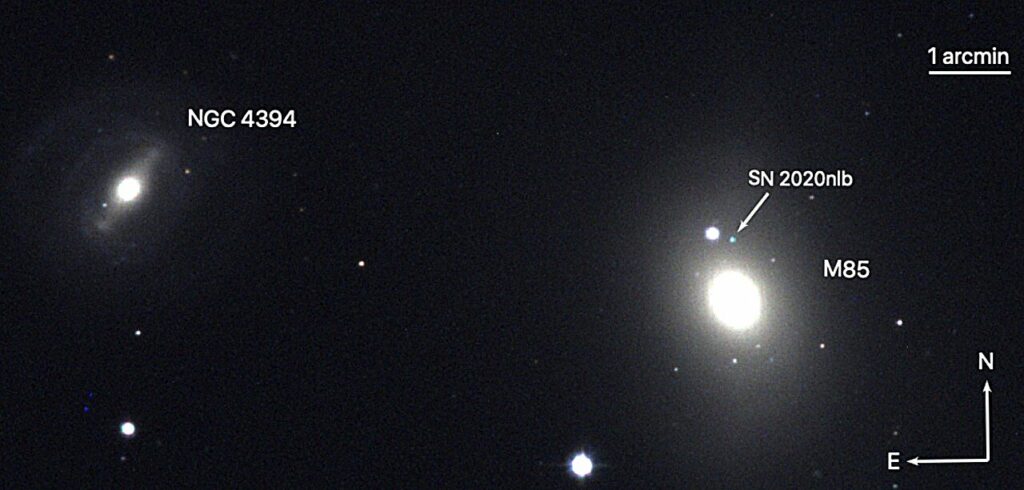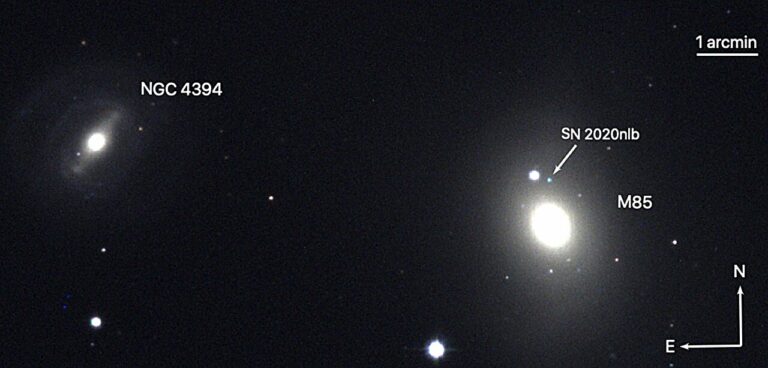Astronomers Examine the Evolution of a Type Ia Supernova in Proximity.
A nearby Type Ia supernova called SN 2020nlb has been extensively studied by astronomers using various ground-based telescopes. The results of these observations, which were presented on January 16 on the pre-print server arXiv, have provided valuable insights into the evolution of this stellar explosion.
Type Ia supernovae, which are found in binary systems with a white dwarf star, are of great importance to the scientific community as they offer crucial information about the evolution of stars and galaxies.
SN 2020nlb was first detected on June 25, 2020, by the Asteroid Terrestrial-impact Last Alert System (ATLAS) shortly after its explosion in the lenticular galaxy Messier 85 (M85). This galaxy is located approximately 60 million light years away. Spectroscopic observations conducted after its detection confirmed that SN 2020nlb is indeed a Type Ia supernova.
Under the leadership of Steven Williams from the University of Turku, Finland, a team of astronomers began monitoring SN 2020nlb just 16 hours after its discovery. The observations, primarily carried out using the Liverpool Telescope (LT) and Nordic Optical Telescope (NOT), have provided a wealth of data about the characteristics of this supernova.
The researchers have provided valuable observations, including one of the earliest high-quality spectra and some of the earliest multi-color photometry of an SN Ia to date.

Williams’ team conducted photometric and spectroscopic observations that spanned nearly 600 days after the explosion of SN 2020nlb. It was determined that the supernova was discovered a mere two days after its initial illumination.
The observations revealed that SN 2020nlb experienced a decrease in brightness of 1.28 mag in the B band within the first 15 days after reaching maximum luminosity. This rate of decline was faster than that of an average Type Ia supernova, indicating a lower luminosity compared to typical SNe in this category.
The spectrum of SN 2020nlb, captured approximately three days after its first light, exhibited prominent features originating from singly ionized metals. Furthermore, a nebular spectrum obtained 594 days after the peak brightness demonstrated the absence of a strong iron emission line, indicating a decrease in the ionization balance of the ejected material.
The earliest spectra of SN 2020nlb resembled those observed during the maximum-light phase of SN 1991bg and similar supernovae. Subsequently, as SN 2020nlb brightened towards its peak, its spectra evolved to become hotter and more akin to SN 2011fe.
The nebular spectra of SN 2020nlb, as stated by the paper’s authors, suggest a potential correlation between the luminosity at peak and the ionization levels during the nebular phase. This observation implies that SN 2020nlb and similar SNe may possess distinct characteristics compared to the majority of typical SN Ia events.
This article is republished from PhysORG under a Creative Commons license. Read the original article.
Do not forget to share your opinion with us to provide you with the best posts !




0 Comments